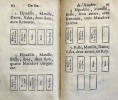[ANONYME].
Le jeu de l'hombre, comme on le joüe présentement à la Cour & à Paris ; où l'on voit comment se joüe espadile forcé, l'hombre à deux, à trois & à cinq. Avec l'explication des termes dont on se sert en le joüant.
Paris, Vve Claude Barbin, 1699. 1699 1 vol. in-12 (170 x 100 mm) de: [5] ff. (titre, avis au lecteur, table); 129 pp.; [7] ff. (table des lois, extrait du privilège); Figures dans le texte. (Ex libris à lencre sur la deuxième page de garde: «Joannis Bap»). Plein veau époque, dos à nerfs orné, titre doré. (reliure frottée, coins et mors usés).
Reference : 5589
Rare édition originale de cet ouvrage exposant les règles du jeu de lHombre, dauteur anonyme bien quattribué à Marie Cochart (1643-1707), imprimeur et autrice, veuve de Claude Barbin (1628-1698). Ce jeu est le plus ancien jeu de levées avec enchères connu, il est donc notamment précurseur du Bridge. Dans ce type de jeu, les joueurs exposent tour à tour une carte sur la table et celui qui a joué la plus forte s'empare de l'ensemble en le levant et en le pliant devant lui, le joueur fait une levée ou un pli. Le jeu de lHombre est inventé en Espagne au début du XVIIe avant darriver en France vers 1650. Toutefois, il semble que son inspiration provienne de «La piazza universale di tutte le professione del mondo»(Venise, 1585) de Tommaso Garzoni, ouvrage traduit par Cristóbal Suárez de Figueroa, «Plaza universal de todas ciencias y artes (Madrid, 1615). En France, on y joue dans la deuxième moitié du XVIIe (attesté dès 1657) et jusqu'au début du XVIIIe siècle où il est finalement remplacé par le quadrille (variante à quatre joueurs). Bien quil existe des variantes à 5 joueurs (le quintille), 4 joueurs (le quadrille, puis le médiateur) et 2 joueurs (le piquemédrille), il se joue originellement à 3 joueurs. L« Hombre » («homme» en espagnol) correspond au joueur qui remporte les enchères, aussi appelé «déclarant», ce dernier devant réussir son contrat. De nos jours, le jeu de lHombre est toujours joué au Danemark sous son ancienne forme ainsi quen Espagne sous la forme du jeu de tresillo, apparu au début du XIXe. Exemplaire bien conservé dans sa reliure dépoque. 1 vol. 12-mo (170 x 100 mm) of : [5] ff. (title, notice to the reader, table); 129 pp. ; [7] ff. (table of laws, excerpt from the privilege); Figures in the text. (Ex libris in ink on the second flyleaf : " Joannis Bap "). Full contemporary calf, spine gilt, gilt title (binding rubbed, corners and spines worn). Rare first edition of this work exposing the rules of the game of Hombre, of anonymous author although attributed to Marie Cochart (1643-1707), printer and author, widow of Claude Barbin (1628-1698). This game is the oldest known game of tricks with bids, and is therefore the precursor of Bridge. In this type of game, the players take turns exposing a card on the table and the one who has played the strongest card takes possession of the set by raising it and folding it in front of him, the player makes a trick or a trick. The game of Hombre was invented in Spain at the beginning of the 17th century before arriving in France around 1650, but it seems to have been inspired by Tommaso Garzoni's "La piazza universale di tutte le professione del mondo" (Venice, 1585), translated by Cristóbal Suárez de Figueroa, "Plaza universal de todas ciencias y artes" (Madrid, 1615). In France, it was played in the second half of the 17th century (attested as early as 1657) and until the beginning of the 18th century when it was finally replaced by the quadrille (a variant with four players). Although there are variants with 5 players (the quintille), 4 players (the quadrille, then the mediator) and 2 players (the piquemédrille), it is originally played with 3 players. The "Hombre" ("man" in Spanish) is the player who wins the bidding, also called the "declarer", who has to pass his contract. Today, the game of Hombre is still played in its old form in Denmark and in Spain in the form of tresillo, which appeared in the early 19th century. A well preserved copy in its original binding.
Bookseller's contact details
J-F Letenneur Livres Rares
M. Jean-François Letenneur
11 bd du tertre Gondan
35800 Saint Briac sur Mer
France
librairie@jfletenneurlivresrares.fr
06 81 35 73 35
 Write to the booksellers
Write to the booksellers



